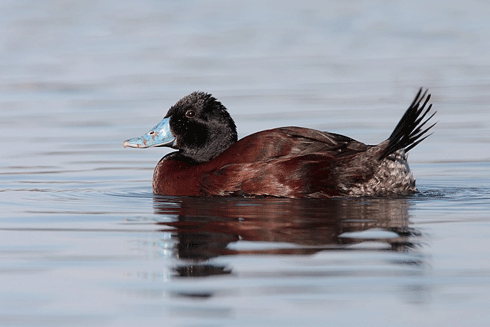
|
Published: 15 October 2012
Birds disappearing at a faster rate than predicted
The rate of bird extinctions is accelerating at an alarming rate, according to the authors of a new paper published in PLoS ONE, ‘Global Patterns and Drivers of Avian Extinctions at the Species and Subspecies Level’.

|
|
A blue billed duck in sewage ponds near Canberra: BirdLife International has classified this species as ‘Near Threatened’. Major threats include drainage of deep permanent wetlands, or their degradation as a result of introduced fish, peripheral cattle grazing, salinisation and lowering of ground water. Credit:
©Simon Bennett (one-off licence for this article only)
|
Lead author, Dr Judit Szabo from Charles Darwin University (CDU), said the study reveals that 279 bird species and subspecies from across the globe have become extinct in the past 500 years. While species extinctions peaked in the early 20th century, then fell until the mid-20th Century, they have have subsequently accelerated.
‘Until this study it had been hoped the rate of extinction was slowing,’ Dr Szabo said.
‘Historically most extinctions have occurred on islands, particularly those in the Pacific, but most of the really susceptible species are long gone.’
The report reveals that the destruction of native habitat for agriculture is currently the main cause of extinctions. Unsustainable hunting and the introduction of species, such as cats and rats, have been main causes of extinctions in the past.
‘Humans are directly or indirectly responsible for this loss,’ Dr Szabo said.
The world’s nations had agreed to slow biodiversity loss by 2010, and having failed to reach this goal, the target has now been adjusted to 2020.
Report co-author and research coordinator at BirdLife International Dr Stuart Butchart said many species survived only because of constant attention and conservation funding.
‘This list would have been much longer were it not for the work being done around the world to stop extinctions. If we act soon we do not have to see extinctions as inevitable.
‘Our analysis assesses current efforts and will help us identify strategies to tackle this loss of biodiversity and minimise future extinctions.’
The study marks an international collaboration between Dr Judit Szabo and Professor Stephen Garnett, also of CDU, and Nyil Khwaja and Dr Stuart Butchart, of BirdLife International.
Source: Charles Darwin University



